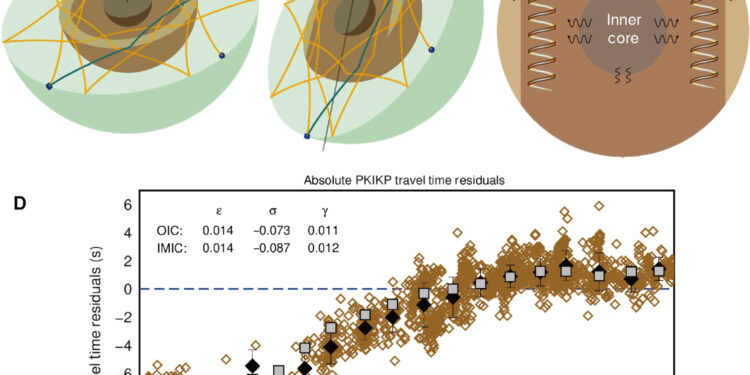Ray path of the K* function, OC heterogeneity diagram and absolute travel time residuals PKIKP. Credit: Scientific progress (2024). DOI: 10.1126/sciadv.adn5562
Scientists from the Australian National University (ANU) have discovered a doughnut-shaped region thousands of kilometres below our feet in the Earth’s liquid core, providing new clues about the dynamics of our planet’s magnetic field.
The structure of the Earth’s liquid core is only present at low latitudes and is parallel to the equator. According to ANU seismologists, it had not been detected until now.
The Earth is made up of two layers: the inner core, a solid layer, and the outer core, a liquid layer. The Earth’s core is surrounded by the mantle. The newly discovered doughnut-shaped region is at the top of the Earth’s outer core, where the liquid core meets the mantle.
Study co-author and ANU geophysicist Professor Hrvoje Tkalčić said the detected seismic waves are slower in the newly discovered region than in the rest of the liquid outer core.
“The region is parallel to the equatorial plane, is confined to low latitudes and has a doughnut shape,” he said.
“We don’t know the exact thickness of the doughnut, but we’ve deduced that it reaches a few hundred kilometers below the core-mantle boundary.”
Rather than using traditional seismic wave observation techniques and observing the signals generated by earthquakes within the first hour, ANU scientists analysed the similarities between waveforms several hours after the earthquake originated, leading them to make this unique discovery.
“By understanding the geometry of the wave trajectories and how they pass through the volume of the outer core, we reconstructed their travel times through the Earth, demonstrating that the newly discovered region has low seismic velocities,” said Professor Tkalčić.
“The peculiar structure has remained hidden until now because previous studies collected data with less volumetric coverage of the outer core by observing waves that were typically confined within an hour of the origin of large earthquakes.
“We were able to get much better volumetric coverage because we studied the reverberant waves for many hours after large earthquakes.”
Dr. Xiaolong Ma, co-author of the study, said the discovery unveils some mysteries of Earth’s magnetic field dynamics. “There are still mysteries about Earth’s outer core that have not been solved, which requires multidisciplinary efforts in seismology, mineral physics, geomagnetism and geodynamics,” Dr. Ma said.
The outer core is made mostly of liquid iron and nickel, and the vigorous movement of the electrically conductive liquid creates the Earth’s magnetic field, which protects the Earth and helps sustain all life, shielding it from harmful solar winds and harmful radiation.
Scientists believe knowing more about the composition of Earth’s outer core, including light chemical elements, is essential to understanding the magnetic field and predicting when it might potentially end or weaken.
“Our results are interesting because this low velocity in the liquid core implies that we have a high concentration of light chemical elements in these regions, which would cause seismic waves to slow down. These light elements, together with temperature differences, contribute to stirring the liquid in the outer core,” said Professor Tkalčić.
“The magnetic field is a fundamental ingredient that we need for life to be sustained on the surface of our planet.
“The dynamics of the Earth’s magnetic field is a field of great interest in the scientific community. Our results could therefore encourage further research into the Earth’s magnetic field and on other planets.”
The research is published in Scientific progress.
More information:
Xiaolong Ma et al., Low-velocity seismic equatorial torus in the Earth’s outer core: Evidence from the late coda correlation wavefield, Scientific progress (2024). DOI: 10.1126/sciadv.adn5562
Provided by Australian National University
Quote:Doughnut-Shaped Region Discovered Inside Earth’s Core Deepens Understanding of Planet’s Magnetic Field (2024, August 30) Retrieved August 31, 2024, from
This document is subject to copyright. Apart from any fair dealing for the purpose of private study or research, no part may be reproduced without written permission. The content is provided for informational purposes only.



